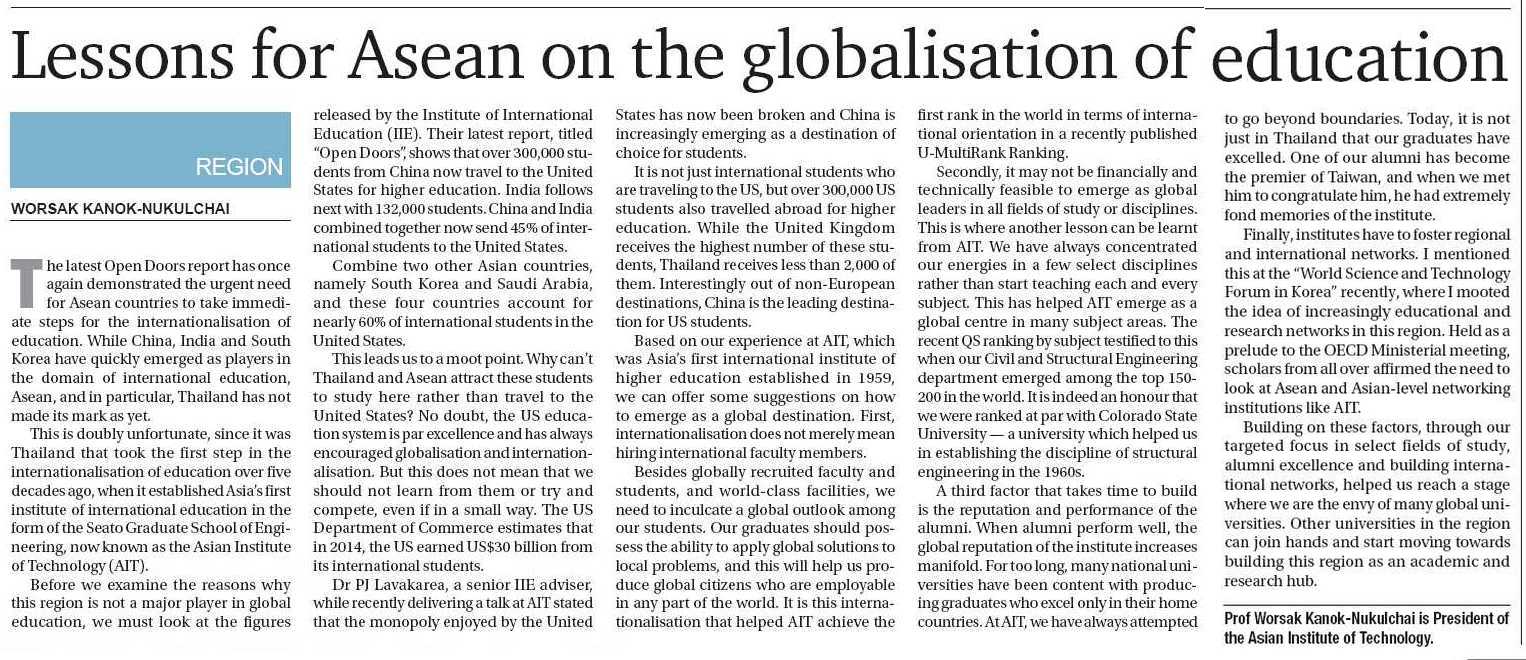The article can be read at this link:
http://www.bangkokpost.com/opinion/opinion/802620/lessons-for-asean-on-the-globalisation-of-education
Lessons for
ASEAN on the globalisation of education
The latest Open Doors report has once again demonstrated the urgent
need for Asean countries to take immediate steps for the
internationalisation of education. While China, India and South Korea
have quickly emerged as players in the domain of international
education, Asean, and in particular, Thailand has not made its mark as
yet.
This is doubly unfortunate, since it was Thailand that took the first
step in the internationalisation of education over five decades ago,
when it established Asia’s first institute of international education
in the form of the Seato Graduate School of Engineering, now known as
the Asian Institute of Technology (AIT).
Before we examine the reasons why this region is not a major player in
global education, we must look at the figures released by the Institute
of International Education (IIE). Their latest report, titled “Open
Doors”, shows that over 300,000 students from China now travel to the
United States for higher education. India follows next with 132,000
students. China and India combined together now send 45% of
international students to the United States.
Combine two other Asian countries, namely South Korea and Saudi
Arabia, and these four countries account for nearly 60% of
international students in the United States.
This leads us to a moot point. Why can't Thailand and Asean attract
these students to study here rather than travel to the United States?
No doubt, the US education system is par excellence and has always
encouraged globalisation and internationalisation. But this does not
mean that we should not learn from them or try and compete, even if in
a small way. The US Department of Commerce estimates that in 2014, the
US earned US$30 billion from its international students.
Dr PJ Lavakarea, a
senior IIE adviser, while recently delivering a talk at AIT stated that
the monopoly enjoyed by the United States has now been broken and China
is increasingly emerging as a destination of choice for students.
It is not just international students who are traveling to the US, but
over 300,000 US students also travelled abroad for higher education.
While the United Kingdom receives the highest number of these students,
Thailand receives less than 2,000 of them. Interestingly out of
non-European destinations, China is the leading destination for US
students.
Based on our experience
at AIT, which was Asia’s first international institute of higher
education established in 1959, we can offer some suggestions on how to
emerge as a global destination. First, internationalisation does not
merely mean hiring international faculty members.
Besides globally
recruited faculty and students, and world-class facilities, we need to
inculcate a global outlook among our students. Our graduates should
possess the ability to apply global solutions to local problems, and
this will help us produce global citizens who are employable in any
part of the world. It is this internationalisation that helped AIT
achieve the first rank in the world in terms of international
orientation in a recently published U-MultiRank Ranking.
Secondly, it may not be
financially and technically feasible to emerge as global leaders in all
fields of study or disciplines. This is where another lesson can be
learnt from AIT. We have always concentrated our energies in a few
select disciplines rather than start teaching each and every subject.
This has helped AIT emerge as a global centre in many subject areas.
The recent QS ranking by subject testified to this when our Civil and
Structural Engineering department emerged among the top 150-200 in the
world. It is indeed an honour that we were ranked at par with Colorado
State University — a university which helped us in establishing the
discipline of structural engineering in the 1960s.
A third factor that takes time to build is the reputation and
performance of the alumni. When alumni perform well, the global
reputation of the institute increases manifold. For too long, many
national universities have been content with producing graduates who
excel only in their home countries. At AIT, we have always attempted to
go beyond boundaries. Today, it is not just in Thailand that our
graduates have excelled. One of our alumni has become the premier of
Taiwan, and when we met him to congratulate him, he had extremely fond
memories of the institute.
Finally, institutes
have to foster regional and international networks. I mentioned this at
the “World Science and Technology Forum in Korea” recently, where I
mooted the idea of increasingly educational and research networks in
this region. Held as a prelude to the OECD Ministerial meeting,
scholars from all over affirmed the need to look at Asean and
Asian-level networking institutions like AIT.
Building on these factors, through our targeted focus in select fields
of study, alumni excellence and building international networks, helped
us reach a stage where we are the envy of many global universities.
Other universities in the region can join hands and start moving
towards building this region as an academic and research hub.
(Prof Worsak
Kanok-Nukulchai is President of the Asian Institute of Technology.)

